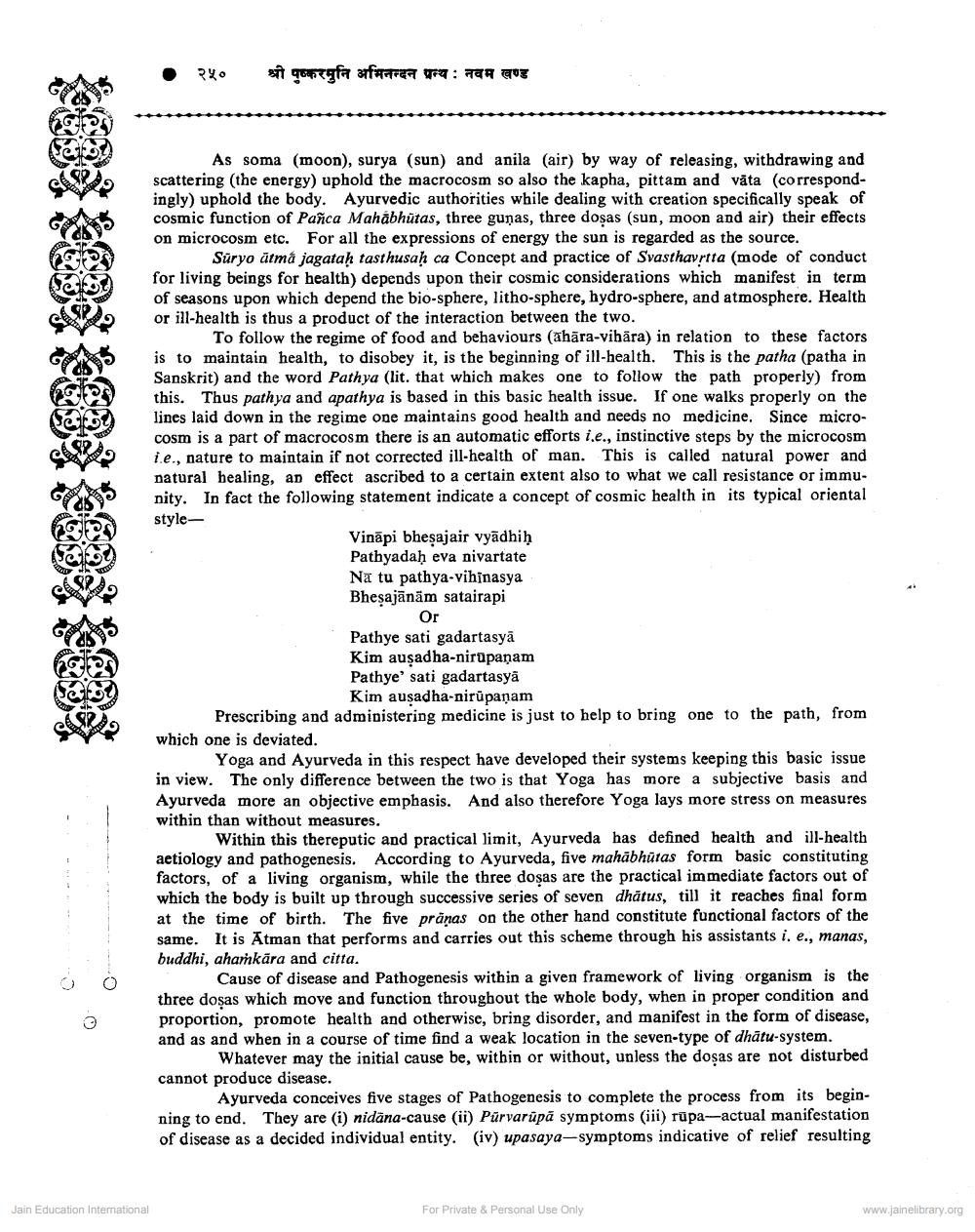________________
CRETS
3
Jain Education International
२५०
श्री पुष्कर मुनि अभिनन्दन ग्रन्थ : नवम खण्ड
As soma (moon), surya (sun) and anila (air) by way of releasing, withdrawing and scattering (the energy) uphold the macrocosm so also the kapha, pittam and vata (correspondingly) uphold the body. Ayurvedic authorities while dealing with creation specifically speak of cosmic function of Panca Mahabhutas, three guņas, three dosas (sun, moon and air) their effects on microcosm etc. For all the expressions of energy the sun is regarded as the source.
Suryo ātmā jagataḥ tasthusaḥ ca Concept and practice of Svasthavṛtta (mode of conduct for living beings for health) depends upon their cosmic considerations which manifest in term of seasons upon which depend the bio-sphere, litho-sphere, hydro-sphere, and atmosphere. Health or ill-health is thus a product of the interaction between the two.
To follow the regime of food and behaviours (ahara-vihara) in relation to these factors is to maintain health, to disobey it, is the beginning of ill-health. This is the patha (patha in Sanskrit) and the word Pathya (lit. that which makes one to follow the path properly) from this. Thus pathya and apathya is based in this basic health issue. If one walks properly on the lines laid down in the regime one maintains good health and needs no medicine. Since microcosm is a part of macrocosm there is an automatic efforts i.e., instinctive steps by the microcosm i.e., nature to maintain if not corrected ill-health of man. This is called natural power and natural healing, an effect ascribed to a certain extent also to what we call resistance or immunity. In fact the following statement indicate a concept of cosmic health in its typical oriental style
Vinäpi bheṣajair vyadhih Pathyadaḥ eva nivartate Na tu pathya-vihinasya Bheṣajānām satairapi Or
Pathye sati gadartasya Kim ausadha-nirupaṇam Pathye' sati gadartasyä Kim auṣadha-nirūpaṇam
Prescribing and administering medicine is just to help to bring one to the path, from which one is deviated.
Yoga and Ayurveda in this respect have developed their systems keeping this basic issue in view. The only difference between the two is that Yoga has more a subjective basis and Ayurveda more an objective emphasis. And also therefore Yoga lays more stress on measures within than without measures.
Within this thereputic and practical limit, Ayurveda has defined health and ill-health aetiology and pathogenesis. According to Ayurveda, five mahābhūtas form basic constituting factors, of a living organism, while the three dosas are the practical immediate factors out of which the body is built up through successive series of seven dhātus, till it reaches final form at the time of birth. The five pränas on the other hand constitute functional factors of the same. It is Atman that performs and carries out this scheme through his assistants i. e., manas, buddhi, ahaṁkāra and citta.
Cause of disease and Pathogenesis within a given framework of living organism is the three dosas which move and function throughout the whole body, when in proper condition and proportion, promote health and otherwise, bring disorder, and manifest in the form of disease, and as and when in a course of time find a weak location in the seven-type of dhātu-system.
Whatever may the initial cause be, within or without, unless the dosas are not disturbed
cannot produce disease.
Ayurveda conceives five stages of Pathogenesis to complete the process from its beginning to end. They are (i) nidäna-cause (ii) Purvarupā symptoms (iii) rupa-actual manifestation of disease as a decided individual entity. (iv) upasaya-symptoms indicative of relief resulting
For Private & Personal Use Only
www.jainelibrary.org




